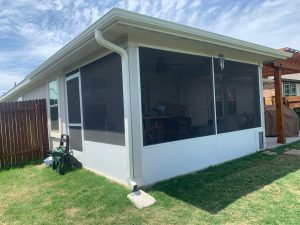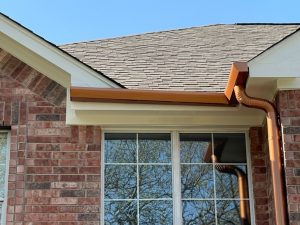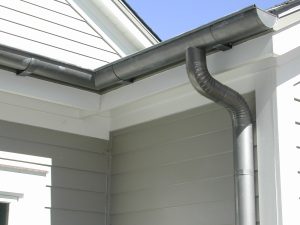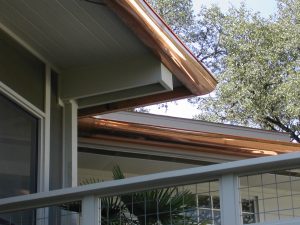What are gutters made of?
Contents
- What are gutters made of?
- PVC, Plastic, and Vinyl Gutters
- Aluminum Gutters
- Galvalume-Steel Gutters
- Copper Metallic Gutters
- Paint-Grip Steel Gutters
- Pure Copper
- Bonderized vs. Galvanized
- Sectional or Seamless?
- Gutter Part Names
- FAQ: Gutter Materials Explained
- What is the most common material for gutters?
- What are residential gutters made of?
- Are gutters metal or plastic?
- Are gutters aluminum or steel?
- What is the longest-lasting gutter material?
- Which is better: aluminum or vinyl gutters?
- What is the longest-lasting guttering?
- What material is the cheapest for gutters?
- What are the lowest maintenance gutters?
- Conclusion
There are various gutter systems to choose from, whether you own an older home that requires replacement gutters or new construction that requires installation. If you’re like most people, this might be the first time you’ve put any mental effort into choosing gutters for your home. Your first thought was probably “I just need gutters” because you ran from your car to your front porch and got drenched. But now that you’re considering investing in your home, you’re wondering, “Is there more to it than ‘just’ gutters?”. There are tons of different profiles out there, but the one thing you’ll have to choose right away is the material that you want. Luckily, you have quite a few choices based on your style, your roof, your budget, and your goals with the home.
PVC, Plastic, and Vinyl Gutters
Doomed from the start
Vinyl gutters are a common choice among homeowners due to their low cost and ease of installation. However, because of our heavier precipitation and varying temperatures all year, they are not a good choice for homes in Texas. Why? Because vinyl gutters are light, they should not be exposed to heavy rainfall or high winds. While vinyl gutters may initially save you money, they will ultimately cost you plenty in the long run, particularly in comparison to other gutter materials.
Most professionals agree that any Vinyl, PVC, or plastic gutter will look bad on the home and need to be replaced sooner rather than later. It’s a disservice in Texas to install it because it can’t withstand the brutal heat of summer and becomes brittle, cracks, and breaks. Since gutter professionals in Texas rarely install these, you’ll likely be doing this yourself in dangerous conditions. An improperly installed system can often cause more damage to your home than not having gutters.
 Pros:
Pros:
- Cheap
- Purchased from big box stores and installed yourself
Cons:
- 1-2 year life span, becomes brittle in the Texas heat
- NOT seamless and leaks at the joints
- No professionals will install it, so you’ll have to do it yourself
- Undersized for normal Texas rains
Aluminum Gutters
The Industry Standard
Aluminum is among the most popular gutter materials and has a few advantages over others. They are frequently inexpensive, and they resist rust better than other metals.
Aluminum is the industry standard in gutters in Texas. It’s the most affordable of the professional materials, lasts a LONG time, and is lightweight and easily formed, so most companies can run it seamlessly or custom form it to any shape you want. Because it comes pre-finished with baked-on enamel paint, the finish lasts over 50 years and can match your existing house colors. Austin Gutter King uses the Senox line of colors, which carry a 50-year warranty.
 Pros:
Pros:
- Durable, lightweight, and never rusts
- comes pre-finished with a range of colors and textures that never require painting
- Seamless
Cons:
- Thinner than steel and more susceptible to damage from hail
Galvalume-Steel Gutters
The “Metal Look”
Galvalume is the industry’s response to the request for galvanized steel. Galvanized steel rusts and dulls over time, eventually causing gutter failure and an unsightly roof line. Galvalume comes in a coil and is most often installed seamlessly. Austin Gutter King uses Senox Galvalume, and it carries a 20-year manufacturer’s warranty.
 Pros:
Pros:
- Steel is heavy-duty
- Maintains its shine and doesn’t rust or dull like Galvanized Steel
- Seamless
Cons:
- Shinier than Galvanized Steel and doesn’t dull, which many people like
- More expensive than aluminum
Copper Metallic Gutters
A copper look at an aluminum price
Copper can be out of reach for many budgets, but for customers wanting a copper look without the price tag, the Copper-Metallic material can be a great choice. It’s technically an aluminum gutter but gives the appearance of copper. Its price is just above the cost of traditional aluminum colors, but nowhere near the cost of copper. This is an excellent choice for customers who prefer the look of copper that never patinas and always maintains its “new” look.
Pros:
- More affordable than pure copper
- Never patinas
- Seamless
Cons:
- Never patinas, which many customers prefer
Paint-Grip Steel Gutters
Paint-Grip Steel (or bonderized steel) is galvanized steel that is processed through a phosphate bath. It’s designed to prohibit corrosion and promotes the life expectancy of paint, or some customers choose to leave it untreated for a rustic metal look. It offers a “duller” look than the more protected Galvalume gutters. The phosphate process insulates the galvanized coating and paint, extending the life of the adhesion to the steel. Because the bare phosphate coating is susceptible to white rust, bonderized steel should be painted immediately after installation.
 Pros:
Pros:
- Classic steel look
- Great for accepting paint
Cons:
- Can eventually rust without regular maintenance.
- More expensive than Galvalume or Aluminum
Pure Copper
Classic Elegance
While copper has benefits and drawbacks, it may be the best choice for vintage homes. Copper gutter systems have been used for a long time, dating back to the 1800s. While copper gutters are eye-catching, they require routine maintenance to keep them looking their finest. Nothing brings a roof line to life like pure copper gutters. On large houses, we usually see them with bold profiles like quarter-round or half-rounds gutters. For smaller Arts & Crafts style houses, copper is commonly used as a decorative half-round. In Texas, the copper will generally fully patina in about three months. Our installers use gloves to ensure there are no fingerprints on the copper. There are many custom options for copper, so be creative with your project consultant and find something that makes your home stand out!
 Pros:
Pros:
- Considered the most beautiful and longest-lasting material
- Generally done in a stylish profile
- Patinas beautifully
Cons:
- Significantly more expensive than other materials
- Will patina, but many customers prefer that
- Requires very skilled installation for soldered miters and end caps
Bonderized vs. Galvanized
Bonderized and galvanized are two types of metal finishes that are commonly used for metal products, including gutters. Here is a brief overview of the differences between bonderized and galvanized metal:
Bonderized
- Bonderized metal is steel treated with a phosphate solution and then coated with a thin zinc-iron alloy layer.
- This process creates a dull gray, matte finish resistant to rust and corrosion.
- Bonderized metal is often used in industrial and architectural applications because of its durability and weather resistance.
- It can be painted over, making it a popular choice for architectural projects where a specific color is desired.
Galvanized
- Galvanized metal is also steel coated with a zinc layer to protect against rust and corrosion.
- The zinc coating creates a shiny, reflective surface that can be silver or gray.
- Galvanized metal is commonly used for outdoor applications, including gutters, because of its resistance to the elements.
- It is also often used for a variety of other metal products, including nails, screws, and wire.
In summary, both bonderized and galvanized metal offer protection against rust and corrosion, but they differ in appearance and application. Bonderized metal has a matte finish, while galvanized metal has a shiny finish.
Sectional or Seamless?
Sectional gutters comprise pieces of gutter connected as they are installed, usually every ten feet or so. Seamless gutters, which come in long rolls of metal and are custom-fitted to each run of your home, are the most common option. Sectional gutters come loose at each joint over time as expansion and contraction occur on your fascia and the metal. Seamless gutters are more affordable than the equivalent material in sectional because it requires less labor than finishing every joint.
Gutter Part Names
Here are the names of some common gutter parts:
- Gutter: The main component collects and channels water away from the roof and down to the downspout.
- Downspout: The pipe that carries water from the gutter to the ground.
- End Cap: The piece is attached to a gutter’s end to close it off.
- Elbow: The curved piece that connects the downspout to the gutter.
- Hanger: The device that attaches the gutter to the roof.
- Splash Block: The flat piece that sits at the bottom of the downspout to prevent water from eroding the soil.
- Bracket: The device that holds the downspout to the wall of the house.
- Outlet: The opening in the gutter that allows water to flow into the downspout.
- Fascia Board: The horizontal board is attached to the roof’s edge and supports the gutter.
- Drip Edge: The metal piece is installed under the shingles and over the fascia board to prevent water from getting behind the gutter.
These are just a few of the standard gutter parts. The specific parts required for your gutter system may vary depending on the type and size of your gutters and the configuration of your roof and downspouts. It’s always a good idea to consult a professional gutter installer to ensure you have all the necessary parts for a functional and effective gutter system.
FAQ: Gutter Materials Explained
What is the most common material for gutters?
The most common material for gutters is aluminum. Aluminum gutters are popular because they are affordable, lightweight, and resistant to rust. They can be seamlessly installed and come in a variety of colors and finishes, making them a versatile choice for many homeowners.
What are residential gutters made of?
Residential gutters can be made from several materials, including aluminum, vinyl, PVC, plastic, galvalume steel, paint-grip steel, and copper. Each material has its own set of advantages and disadvantages, depending on the climate, budget, and aesthetic preferences of the homeowner.
Are gutters metal or plastic?
Gutters can be made from both metal and plastic. Common metal options include aluminum, galvalume steel, paint-grip steel, and copper. Plastic options include vinyl and PVC. Metal gutters tend to be more durable and longer-lasting, while plastic gutters are typically more affordable and easier to install but less durable.
Are gutters aluminum or steel?
Gutters can be made from both aluminum and steel. Aluminum gutters are lightweight, rust-resistant, and available in many colors. Steel gutters, such as galvalume-and paint-grip steel, are heavier and more durable but can be more expensive and require more maintenance to prevent rust.
What is the longest-lasting gutter material?
Pure copper gutters are considered the longest-lasting material. They can last over 50 years with proper maintenance and develop a beautiful patina over time. However, they are also significantly more expensive than other gutter materials.
Which is better: aluminum or vinyl gutters?
Aluminum gutters are generally better than vinyl gutters. Aluminum is more durable, can be seamlessly installed, and does not become brittle in extreme temperatures, unlike vinyl. Vinyl gutters are cheaper and easier to install but have a shorter lifespan and can crack or warp in harsh weather conditions.
What is the longest-lasting guttering?
Pure copper gutters are the longest-lasting guttering option. They are highly durable and can last for several decades, developing a patina that many homeowners find attractive.
What material is the cheapest for gutters?
Vinyl gutters are the cheapest option for gutters. They are affordable and easy to install, but they are not recommended for areas with heavy rainfall or extreme temperatures due to their shorter lifespan and susceptibility to damage.
What are the lowest maintenance gutters?
Aluminum gutters are considered low-maintenance. They are resistant to rust and do not require painting if you choose pre-finished options. They can also be installed seamlessly, reducing the risk of leaks and minimizing the need for repairs.
Conclusion
Rain gutters are an important part of your home, and choosing the material that is best for your specific needs is essential. Aluminum, copper, and steel all have advantages and disadvantages, so take the time to research each material before deciding. Additionally, consider the environment when selecting a material since some materials are more eco-friendly than others. Be sure to consult with a professional if you have any questions, as they will be able to provide advice based on your individual situation.
Gutter King can guide you through the process and ensure you’re getting the right materials, style, and highest quality available. Also, check out our overview of the different profiles of gutters available.

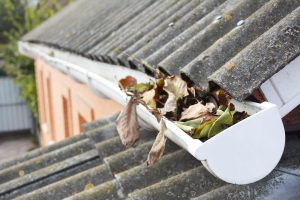 Pros:
Pros: